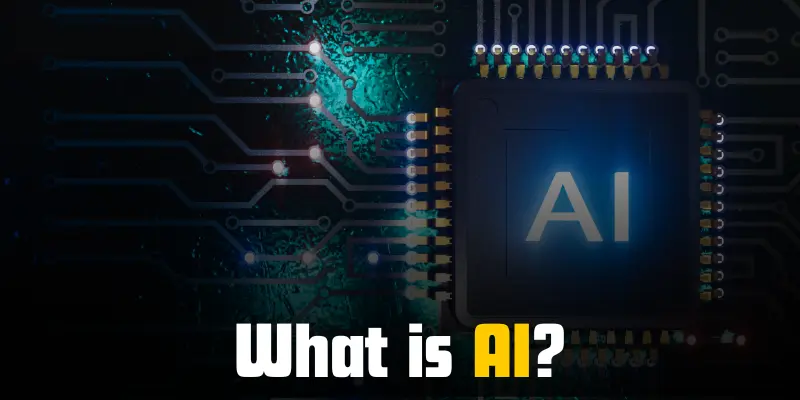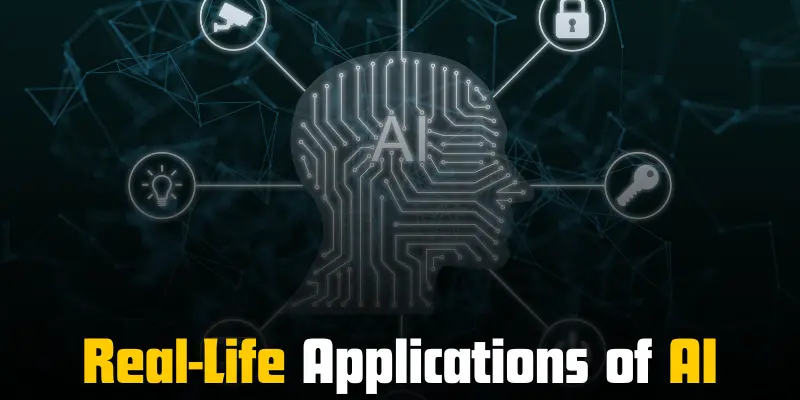How Does AI Work? Simple Explanation & Real-Life Examples
Published: 5 Feb 2025
Imagine a world where machines can learn from experience, recognize patterns, and even make decisions—all without human help. This world is not in the distant future; it’s happening right now with AI. Whether you’re asking Siri for directions or using a chatbot for customer support, AI is quietly working behind the scenes. But how does it actually work? Let’s break it down step by step.
Introduction
Artificial Intelligence (AI) is all around us, from the voice assistant on your phone to the personalized recommendations on your favorite shopping websites. But AI is much more than just a tool—it’s a technology that’s reshaping industries, making tasks easier, and improving decision-making processes in ways we never imagined. Understanding how AI works is becoming increasingly important as it continues to play a bigger role in our everyday lives.
In this post, we’ll break down How Does AI Work, explain how it learns from data, and explore the real-world ways it’s being used today. By the end, you’ll have a clear idea of how AI works and why it matters.
What is AI?

AI Defined in Simple Terms
- AI stands for Artificial Intelligence, which means teaching machines to think and learn like humans.
- Instead of being programmed to perform one task, AI can adapt, learn from experience, and solve problems on its own.
Machines Designed to Think Like Humans
- AI systems use data to make decisions or predictions without needing direct instructions.
- They can recognize patterns, learn new information, and even improve over time.
- These systems are designed to perform tasks that usually require human intelligence, such as reasoning, problem-solving, and understanding speech.
Examples of AI in Everyday Life
- Virtual Assistants: Siri, Alexa, and Google Assistant can understand your voice and perform tasks like setting reminders or answering questions.
- Recommendation Systems: AI is behind the movie or music suggestions you get on platforms like Netflix or Spotify, learning what you like over time.
- Self-Driving Cars: AI helps cars navigate and make decisions on the road, using sensors and data to avoid obstacles and follow traffic rules.
Key Concepts in AI
Machine Learning (ML)
What is ML?
- Machine Learning (ML) is a type of AI that allows machines to learn from data and improve over time.
- Instead of being directly programmed to do specific tasks, ML systems learn patterns from examples and make decisions based on that data.
Example: Netflix Recommendations
- Netflix uses ML to suggest movies or shows based on your viewing history.
- The more you watch, the better the system understands your preferences and offers better recommendations.
Neural Networks
What are Neural Networks?
- Neural networks are AI systems designed to work like the human brain.
- They use layers of connected nodes (like neurons in the brain) to process and learn information.
- These systems can recognize patterns, classify data, and make decisions.
Example: Image Recognition
- Neural networks are used to recognize objects in photos.
- For example, AI can identify faces in pictures or sort images based on categories like “cats” or “dogs.”
Deep Learning
What is Deep Learning?
- Deep learning is a more advanced type of machine learning that uses large amounts of data and multiple layers of neural networks to make complex decisions.
- It mimics the brain’s ability to process information in layers, learning increasingly detailed features.
Example: Voice Recognition Technology
- Voice assistants like Siri or Google Assistant use deep learning to understand and respond to your speech.
- The more data (voice samples) the system receives, the better it gets at understanding different accents, languages, and speech patterns.
How AI Learns
Data Collection
- AI needs large amounts of data to understand the world and improve its skills.
- The more data it gets, the better it can learn patterns and make accurate decisions.
- This data can come from different sources, such as text, images, videos, or sensor readings.
Example:
- AI can learn to play chess by studying thousands of games, analyzing each move, and understanding winning strategies. The more games it “sees,” the better it gets at predicting the best moves.
Training Models
- Training is like teaching the AI by giving it examples and feedback.
- AI uses these examples to recognize patterns and make decisions without being directly told what to do.
- It’s like showing a child different types of animals until they can tell the difference on their own.
Example:
- Teaching AI to identify photos of cats vs. dogs involves showing it thousands of images labeled “cat” or “dog.” Over time, AI learns to spot the unique features of each animal, such as fur patterns and shapes, to make accurate guesses.
Testing & Adjusting
- After learning from data, AI tests its knowledge to see if it’s making accurate predictions.
- If it makes mistakes, it adjusts its approach based on new information. This helps the AI improve over time.
- This cycle of testing and adjusting is what makes AI “smarter” the more it learns.
Example:
- AI used for weather predictions starts by comparing historical data with actual weather patterns. As it tests its predictions against real-world weather, it adjusts its models to make future forecasts more accurate.
Real-Life Applications of AI

Everyday AI Examples
Smartphones (e.g., Face Recognition)
- AI helps unlock your phone by recognizing your face.
- It learns your facial features over time and can still recognize you, even if you wear glasses or change your hairstyle.
- Example: Face ID on iPhones, which uses AI to securely identify you.
Online Shopping (e.g., Product Recommendations)
- AI tracks your browsing history and suggests products based on what you’ve looked at or purchased.
- It learns what you like and improves its suggestions to help you find new items faster.
- Example: Amazon’s personalized recommendations based on your shopping habits.
AI in Business & Industry
Healthcare (e.g., AI Diagnosing Diseases)
- AI can analyze medical images (like X-rays or MRIs) to spot signs of diseases such as cancer or pneumonia.
- It helps doctors by providing a second opinion, making diagnoses faster and more accurate.
- Example: AI-powered tools that help doctors identify tumors early in radiology.
Finance (e.g., Fraud Detection)
- AI systems monitor transactions for unusual patterns, like a sudden large withdrawal or purchase from a new location, to detect potential fraud.
- It can quickly flag suspicious activity, allowing banks to stop fraud before it happens.
- Example: AI in credit card companies automatically detecting fraudulent transactions based on patterns.
Benefits and Challenges of AI
Benefits of AI
Faster Decisions
- AI can analyze large amounts of data in seconds, helping to make quick decisions that would take humans much longer.
- Example: AI in customer service chatbots instantly answers questions, saving time for both customers and businesses.
Better Accuracy
- AI can detect patterns or problems that humans might miss, leading to more precise results.
- Example: AI-powered translation tools like Google Translate provide accurate translations between languages, helping people communicate better across cultures.
Saves Time
- AI automates repetitive tasks, allowing people to focus on more creative or complex work.
- Example: AI in email filters sorts messages, saving users time by categorizing important and spam emails.
Challenges of AI
Privacy Concerns
- AI systems collect and analyze large amounts of personal data, raising concerns about how that information is used and stored.
- Example: AI-powered surveillance systems could track individuals without their consent, leading to privacy issues.
Job Loss Fears
- As AI automates tasks, there’s concern that jobs, especially in industries like manufacturing and customer service, could be replaced by machines.
- Example: Self-checkout machines in grocery stores are replacing cashiers, which can lead to job displacement.
Ethical Issues
- Decisions made by AI can sometimes be biased or unfair, depending on the data used to train them.
- Example: Self-driving cars may face ethical dilemmas in situations where they have to make decisions that impact human lives (e.g., who to harm in an unavoidable accident).
Conclusion
So guys, in this article, we’ve covered How Does AI Work in detail. Hopefully, you now have a clearer understanding of how AI learns, adapts, and is applied in various aspects of our lives.
If you’re interested in exploring AI further, I highly recommend checking out more resources or trying out AI tools yourself to see the magic in action.
Remember, AI is constantly evolving, and staying informed will help you make the most of its benefits. Don’t forget to share this post with anyone curious about AI!
FAQs About How AI Works
AI (Artificial Intelligence) is the technology that allows machines to think, learn, and make decisions like humans. It helps computers or machines solve problems, recognize patterns, and improve over time without being specifically programmed for each task. Examples include voice assistants like Siri or Alexa.
AI learns by analyzing large amounts of data and finding patterns or rules in that data. It uses this information to make predictions or decisions. The more data it gets, the better it can perform tasks, just like how we learn from experience.
No, AI isn’t quite like human intelligence. AI can mimic certain human tasks, like recognizing faces or understanding speech, but it doesn’t have emotions, creativity, or complex reasoning like we do. It works by processing data, not by thinking like a human.
Yes, AI can make mistakes, especially if it’s trained on poor or biased data. For example, it might misinterpret an image or fail to understand a question properly. However, as it gets more data and experience, it tends to improve over time.
In your phone, AI helps with things like voice recognition (e.g., Siri or Google Assistant), camera features (like auto-focus), and even battery saving by learning your usage patterns. It also recommends apps and sorts notifications to improve your experience.
AI is good at automating repetitive tasks, but it’s unlikely to replace jobs that need human creativity or emotions, like art or teaching. Instead, AI will likely change the way we work, helping people do their jobs more efficiently. It’s also creating new types of jobs we never had before.
Since AI uses data to make decisions, it can raise concerns about privacy. For example, AI systems can collect personal information, like your location or preferences, without you always being aware. It’s important for AI systems to handle this data securely and responsibly.
AI is the broad concept of machines being able to carry out tasks that would normally require human intelligence. Machine Learning (ML) is a specific type of AI that teaches machines to learn from data and improve over time without being directly programmed. ML is a key part of AI.

- Be Respectful
- Stay Relevant
- Stay Positive
- True Feedback
- Encourage Discussion
- Avoid Spamming
- No Fake News
- Don't Copy-Paste
- No Personal Attacks

- Be Respectful
- Stay Relevant
- Stay Positive
- True Feedback
- Encourage Discussion
- Avoid Spamming
- No Fake News
- Don't Copy-Paste
- No Personal Attacks



